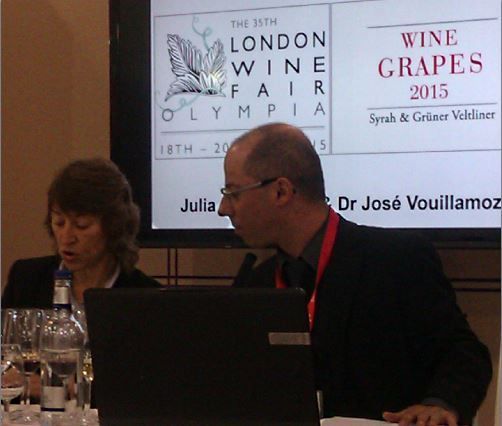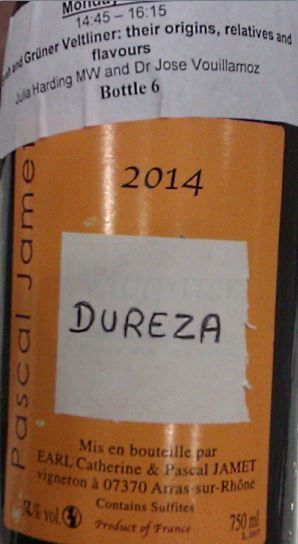Syrah, Shiraz, Gruner Veltliner and family

I was lucky to be able to attend a wine grape varieties Masterclass about Grüner Veltliner and Syrah by Julie Harding MW and Dr José Vouillamoz, co-authors with Jancis Robinson MW of the comprehensive book ‘Wine Grapes’.

This was a packed seminar with many unable to get seated and having to stand at the back. Julie and Jose talked about connections between varieties that have been proved by DNA research. Slides of the family trees of Grüner Veltliner and Syrah showed that both were related to Pinot Noir and there are other surprising connections.
Parents of Grüner Veltliner are Savagnin and St Georgener, but there’s only one known vine of the latter although it’s been propagated with the first vintage due in 2016 so we tasted two Grüner Veltliner. That sole St Georgener was later vandalised but managed to survive, and Jose showed us photos of before and after. The before showed a sprawling vine that looked like an abandoned wild vine.
Tatomer, Meeresboden Grüner Veltliner 2013, Santa Barbara County – Full bodied rounded soft smooth with spicy finish, some planted 2008 and others grafted onto old vines in 2011, half aged in 500 litre barrels.
Alois Hollerer Alte Reben Grüner Veltliner 2014, Austria – spicy, soft acids approachable and concentrated from 50+ year old vines. Whole bunch pressed, stainless steel fermented aged in 1,500 litre Austrian oak barrels.
We then tasted two Savagnins. Savagnin, Traminer, Gewürztraminer and Heida are all synonyms for the same variety.
Dom des Muses Heida Tradition 2012 Valais Switzerland—Heida means ‘very old’, Fresh rounded and smooth, all stainless steel, no oak treatment. Good acidity giving vibration to this wine.
Dom des Cavarodes, Ostrea Virgula Savagnin 2012, Jura, France – Biodynamic, aged on lees, a ‘natural’ ‘orange’ wine aged on its lees. Funky, woody, ugh.

The parents of Syrah, also known as Shiraz, are Mondeuse Blanche and Dureza. There’s been a huge increase in plantings of Syrah/Shiraz: 50 years ago it was the 35th most planted variety worldwide, now it’s the 6th most planted variety. There’s only 5ha of Mondeuse Blanche planted worldwide, though more is being planted as a result of discovery of its family connection with Syrah. There’s one vineyard of Dureza, planted in 2010 and 2014 was the first vintage with 110 litres made. This was the very first public tasting of varietal Dureza.
Philippe Grisard, Mondeuse Blanche 2013, Savoie France – 2,000 bottles made, aged in lees. Slight apricot aromas, soft ripe, full bodied, rich and fat in the mouth, lacking acidity and finishes short. Has parent-child relationship with Viognier, and there are some similarities in mouthfeel.
Pascal Jamet, Dureza 2014, Ardeche, France. -- Light bright purple colour, lot of spices with white pepper. You can see Syrah in it. Chewy with big tannins, taut linear – l’d like to see it with a bit more age, this was a tank sample.
Yves Gangloff, La Sereine Noir 2011, Cote Rotie, France – Sereine is an old synonym for Syrah. 4,500 bottles made, aged two years in 228 litre barrels, unfined and unfiltered. This is a big sophisticated linear Syrah with restrained fruits and pepper. Very nice.
Henschke, Mount Edelstone Shiraz 2010, Eden Valley, Australia. Planted in 1912 this is the oldest continuously produced single vineyard in Australia. Finished off in 300 litre hogsheads this has a strong sweet violet perfume and taste with a spicy finish. I find it to concentrated and overpowering to want to drink more than a glass.

The world's first bottle of varietal Dureza -- the name is handwritten on by the winemaker for this tank sample.
Talk about wine on our forum.
Peter F May is the author of Marilyn Merlot and the Naked Grape: Odd Wines from Around the World which features more than 100 wine labels and the stories behind them, and PINOTAGE: Behind the Legends of South Africa’s Own Wine which tells the story behind the Pinotage wine and grape.
which features more than 100 wine labels and the stories behind them, and PINOTAGE: Behind the Legends of South Africa’s Own Wine which tells the story behind the Pinotage wine and grape.

Related Articles
Editor's Picks Articles
Top Ten Articles
Previous Features
Site Map
Content copyright © 2023 by Peter F May. All rights reserved.
This content was written by Peter F May. If you wish to use this content in any manner, you need written permission. Contact Peter F May for details.

This was a packed seminar with many unable to get seated and having to stand at the back. Julie and Jose talked about connections between varieties that have been proved by DNA research. Slides of the family trees of Grüner Veltliner and Syrah showed that both were related to Pinot Noir and there are other surprising connections.
Parents of Grüner Veltliner are Savagnin and St Georgener, but there’s only one known vine of the latter although it’s been propagated with the first vintage due in 2016 so we tasted two Grüner Veltliner. That sole St Georgener was later vandalised but managed to survive, and Jose showed us photos of before and after. The before showed a sprawling vine that looked like an abandoned wild vine.
Tatomer, Meeresboden Grüner Veltliner 2013, Santa Barbara County – Full bodied rounded soft smooth with spicy finish, some planted 2008 and others grafted onto old vines in 2011, half aged in 500 litre barrels.
Alois Hollerer Alte Reben Grüner Veltliner 2014, Austria – spicy, soft acids approachable and concentrated from 50+ year old vines. Whole bunch pressed, stainless steel fermented aged in 1,500 litre Austrian oak barrels.
We then tasted two Savagnins. Savagnin, Traminer, Gewürztraminer and Heida are all synonyms for the same variety.
Dom des Muses Heida Tradition 2012 Valais Switzerland—Heida means ‘very old’, Fresh rounded and smooth, all stainless steel, no oak treatment. Good acidity giving vibration to this wine.
Dom des Cavarodes, Ostrea Virgula Savagnin 2012, Jura, France – Biodynamic, aged on lees, a ‘natural’ ‘orange’ wine aged on its lees. Funky, woody, ugh.

The parents of Syrah, also known as Shiraz, are Mondeuse Blanche and Dureza. There’s been a huge increase in plantings of Syrah/Shiraz: 50 years ago it was the 35th most planted variety worldwide, now it’s the 6th most planted variety. There’s only 5ha of Mondeuse Blanche planted worldwide, though more is being planted as a result of discovery of its family connection with Syrah. There’s one vineyard of Dureza, planted in 2010 and 2014 was the first vintage with 110 litres made. This was the very first public tasting of varietal Dureza.
Philippe Grisard, Mondeuse Blanche 2013, Savoie France – 2,000 bottles made, aged in lees. Slight apricot aromas, soft ripe, full bodied, rich and fat in the mouth, lacking acidity and finishes short. Has parent-child relationship with Viognier, and there are some similarities in mouthfeel.
Pascal Jamet, Dureza 2014, Ardeche, France. -- Light bright purple colour, lot of spices with white pepper. You can see Syrah in it. Chewy with big tannins, taut linear – l’d like to see it with a bit more age, this was a tank sample.
Yves Gangloff, La Sereine Noir 2011, Cote Rotie, France – Sereine is an old synonym for Syrah. 4,500 bottles made, aged two years in 228 litre barrels, unfined and unfiltered. This is a big sophisticated linear Syrah with restrained fruits and pepper. Very nice.
Henschke, Mount Edelstone Shiraz 2010, Eden Valley, Australia. Planted in 1912 this is the oldest continuously produced single vineyard in Australia. Finished off in 300 litre hogsheads this has a strong sweet violet perfume and taste with a spicy finish. I find it to concentrated and overpowering to want to drink more than a glass.

The world's first bottle of varietal Dureza -- the name is handwritten on by the winemaker for this tank sample.
Talk about wine on our forum.
Peter F May is the author of Marilyn Merlot and the Naked Grape: Odd Wines from Around the World

Related Articles
Editor's Picks Articles
Top Ten Articles
Previous Features
Site Map
Content copyright © 2023 by Peter F May. All rights reserved.
This content was written by Peter F May. If you wish to use this content in any manner, you need written permission. Contact Peter F May for details.


